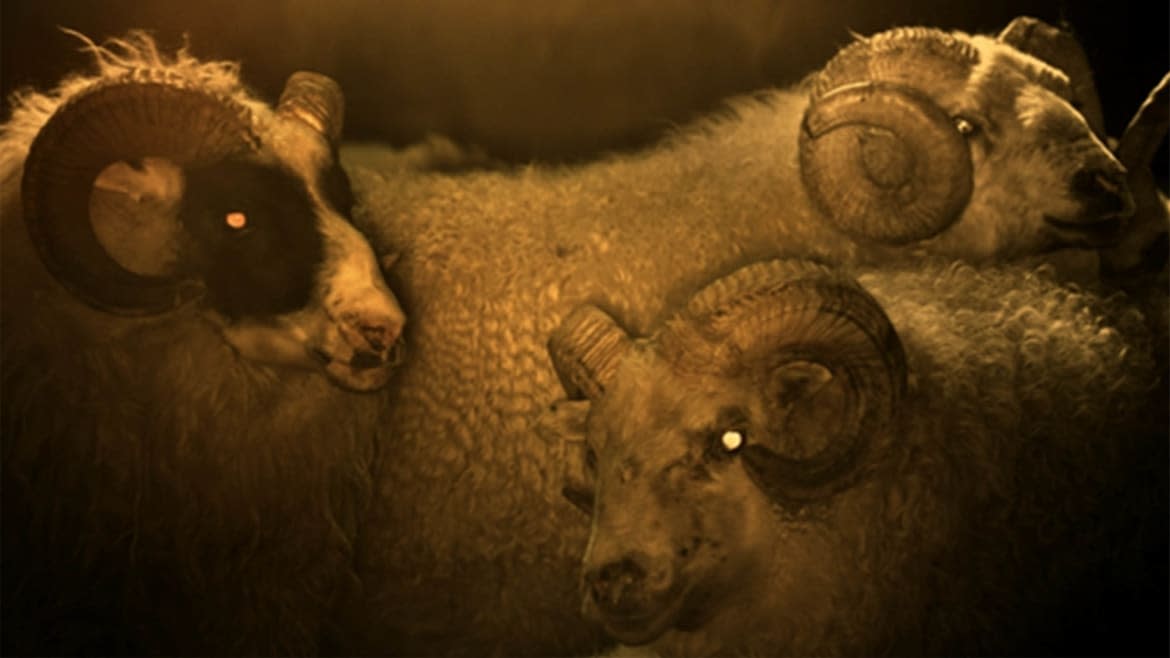‘Lamb’ Is the Lamb-Human Hybrid Horror Movie That Will Haunt Your Dreams

After more than a year mostly spent in a shoebox-sized one-bedroom apartment, the opening scenes of Lamb, A24’s latest slow-simmering horror film, felt like a much-needed breath of fresh air—specifically, a crisp Icelandic breeze. María and Ingvar, married but childless, run a farm together and raise sheep. Their existence seems idyllic at first, dyed in appealing shades of indigo and white and set against sweeping plains of fresh grass. But it doesn’t take long for this agrarian utopia to lose its luster.
Director Valdimar Jóhannsson builds his tension slowly, undermining the sentimentality outsiders might associate with agrarian life via quietly unsettling moments. Former Girl with the Dragon Tattoo Noomi Rapace plays María, who swells with maternal pride as she helps a ewe deliver her lambs. A few minutes later, she’s comforting a screaming lamb while the camera slowly pushes in on its bleeding, freshly tagged ear.

Noomi Rapace and Hilmir Snær Guðnason in Lamb
María and Ingvar (Hilmir Snær Guðnason) barely speak to one another, save for a conversation about time travel that hints at their shared desire to travel back in time. (Perhaps together, perhaps not.) Rapace plays María with gentle reticence at first, allowing the character’s ruthlessness to seep out quietly over time. Guðnason, meanwhile, oozes resigned desperation. The source of their grief—and stiffness around one another—becomes clearer when, days after giving birth, the ewe delivers one last infant.
Steve McQueen Is Not Here for ‘Happy-Clappy’ Disney Movies
Although Jóhannsson does not immediately reveal what about this late arrival sparks the shocked expressions on María and Ingvar’s faces, it’s easy enough to guess. Ingvar fetches an old, disused crib from the couple’s shed, along with linens stored in weather-proof garbage bags. We observe the lamb swaddled in blankets while her brethren remain in the barn outside, and eventually her hybrid form reveals itself. “Ada,” as María and Ingvar call her, is neither lamb nor human—but the couple, wracked with grief they cannot speak aloud at the dinner table, claim her for themselves.
Lamb is not a horror-comedy in the vein of, say, the 2006 killer-mutton movie Black Sheep—but the film does have a certain bleak sense of humor. Jóhannsson mines his comedy from María and Ingvar’s obvious ridiculousness. Ingvar’s brother, Pétur (Björn Hlynur Haraldsson), becomes the voice of the audience early on when he drops in, meets his “niece,” and incredulously asks his brother: “What the fuck is this?” Ingvar’s answer? “Happiness.”
Jóhannsson commits to the absurdity of his premise but resists even the slightest whiff of goofiness in favor of something more literary. María and Ingvar’s desire to become surrogate parents to a sheep-baby both highlights the confusing behavior that can result from unexamined grief. Both María and Ingvar see Ada as a new beginning for themselves, and it never seems to occur to them that such a thing would be untenable.
The couple’s seemingly instantaneous decision to claim Ada as their own also amplifies a dynamic many of us refuse to acknowledge. Soon after María and Ingvar abscond with the infant lamb, her mother—played by a sheep who makes yet another case for animal Oscars—becomes frantic in her attempts to retrieve Ada. She bleats relentlessly under the infant’s window until María, exasperated and threatened, looks her straight in the eye and shoots her—driving a bolt gun through any dewy-eyed illusions about the relationship between farmer and flock. Whatever sepia-toned notions people might have about agrarian life, Lamb seems to argue, María and Ingvar’s sheep are still just commodities. They prize Ada for her humanity but reject the notion that the creature who birthed her carries the same value; while Ada wears flower crowns, her wool emerging from underneath a blue cord sweater, her mother, known only by a number pierced into her ear, is disposable as soon as she becomes an inconvenience.
The film’s ending—which, even after all of the bonkers proceedings before it, elicited the first actual “What the fuck?!” from a fellow attendee at my screening—feels fated from the start but no less shocking upon execution. Throughout the film, disquieting shots of the strangely expressive cat, the anxious family shepherd, and throngs of huffing, glowing-eyed sheep hint that María and Ingvar’s position at the top of the food chain might be less secure than they believe. Jóhannsson’s final scene delivers on those unsettling hints with a gonzo twist that comes and goes just quickly enough before the credits roll to work.
Comparisons to The Witch feel inevitable not only because of their shared studio and deliberate pace, but also because of the Black Phillip of it all. While the demonic goat represented Anya Taylor-Joy’s decision to eschew her family’s puritanical, patriarchal values and “live deliciously” for herself, Lamb’s flock of sheep—and tiny Ada—invite the audience to interrogate the lies we tell ourselves, both on an individual and more broadly human level. Like much of A24’s horror output, this one feels bound to be divisive—but like the others, it’s far too fascinating to miss.
Get our top stories in your inbox every day. Sign up now!
Daily Beast Membership: Beast Inside goes deeper on the stories that matter to you. Learn more.

 Yahoo Movies
Yahoo Movies 
